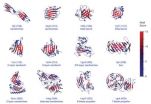(Press-News.org) Proteins are chains of amino acids that, when folded into certain structural patterns and also when unfolded, exert functions within cells. Proteins receive signals that are transmitted from one to the next and that are essential for life. However, within a given protein, are there "highways" along which the signals travel, like a in a relay event? That is to say, how is the information transmitted in a given protein? "This is one of the key questions in biophysics," says Xavier Salvatella, ICREA Professor at the Institute for Research in Biomedicine (IRB Barcelona) and head of the Molecular Biophysics Lab.
The most recent study in this field published today in Nature Communications, in collaboration with Modesto Orozco, an expert in biocomputational simulations who also works at IRB Barcelona, shows that the transmission of information over large distances occurs within proteins. This transmission has been observed and demonstrated for all proteins containing beta sheets, one of two structural patterns that folded proteins adopt.
"We are discovering the information transmission pathways inside proteins and this concept, which we have validated for one kind of protein structural motif, allows us to speculate that proteins have many valid surfaces on which a drug can act," relates Salvatella.
The team of scientists have discovered how the motions of various parts of proteins, although physically far apart, are correlated. "The same thing happens to proteins as happens to the choreography of ballet dancers, where the movements of the participants are interconnected in spite of being physically apart. If the first one lifts an arm, the last one lifts an arm too," describes the researcher.
A gold mine for drug discovery
Drugs act on a certain site or active domain of a target protein in a given disease. In most infectious diseases and in cancer, one of the problems is that the site where the drug interacts evolves and mutates and the drug is rendered inefficient. The concept, now validated by IRB Barcelona researchers, allows one to think that the site where the drug was headed is equally as valid as any other point along the transmission pathway.
"If this were this case – which is what our data show – we would be able to find many sites within the structure of a protein that would be equally or more efficient at interacting with a drug. Sites that, although lying far from the key or functional site of the protein, would have the same effect," argues Salvatella.
The scientist goes on to explain that there are already many drugs that act at sites that are not the actives sites but that these drugs have been discovered by serendipity, through massive screenings of molecules and observing that they bound to an unexpected site. "This system is clearly not efficient. We have to be able to organise it and if we manage to do this, then we will have a potent way to discover new drugs," explains the researcher.
In addition to furthering the conceptual field, Salvatella is working with proteins of biomedical interest. "We already know enough to study in parallel the pathways of proteins of biomedical interest. If we are successful, we will have discovered a gold mine for drug discovery," affirms the scientist.
The first authors of the article are the postdoctoral fellows Bryn Fenwick, a former member of Xavier Salvatella's group, currently at the Scripps Research Institute of California, and Laura Orellana, a former member of Modesto Orozco's group, who is now at the Science for Life Laboratory at the Royal Institute of Technology in Stockholm. The work has been done within the joint programme in Computational Biology between BSC, CRG and IRB Barcelona.
INFORMATION:
Reference article:
Correlated motions are a fundamental property of β-sheets
R. Bryn Fenwick, Laura Orellana, Santi Esteban-Martín, Modesto Orozco, and Xavier Salvatella
Nature Communications (2014) doi: 10.1038/ncomms5070
The transmission of information via proteins could revolutionize drug discovery
A study by the scientists Xavier Salvatella and Modesto Orozco at IRB Barcelona reveals the existence of information highways that connect and correlate distant sites within a single protein.
2014-06-12
ELSE PRESS RELEASES FROM THIS DATE:
Tiny plants ride on the coattails of migratory birds
2014-06-12
Since the days of Darwin, biologists have questioned why certain plants occur in widely separated places, the farthest reaches of North American and the Southern tip of South America but nowhere in between. How did they get there? An international team of researchers have now found an important piece of the puzzle: migratory birds about to fly to South America from the Arctic harbor small plant parts in their feathers.
In the past several decades, scientists have discovered that the North – South distributions of certain plants often result from a single jump across the ...
Chimpanzees spontaneously initiate and maintain cooperative behavior
2014-06-12
VIDEO:
Chimpanzees spontaneously cooperate with multiple partners of their choosing to remove a barrier and pull in a tray baited with food.
Click here for more information.
Without any pre-training or restrictions in partner choice among chimpanzees, researchers at the Yerkes National Primate Research Center, Emory University, found for the first time that chimpanzees housed in a socially complex, contained setting spontaneously cooperate with multiple partners of their choosing. ...
All men with gout should be routinely screened for erectile dysfunction
2014-06-12
A new study presented today at the European League Against Rheumatism Annual Congress (EULAR 2014) showed that erectile dysfunction (ED) is present in most men with gout and is frequently severe.1
In a survey of 201 men, 83 had gout, of whom a significantly greater proportion had ED (76%) compared with those patients without gout (52%) (p= 0.0007). Also, a significantly greater proportion of gout patients (43%) had severe ED compared with patients without gout (30%) (p=0.007).1
According to lead author Dr. Naomi Schlesinger, Chief, Division of Rheumatology and Professor ...
Potential anti-TNF response biomarker identified
2014-06-12
DNA methylation has been identified as a potential biomarker of response to etanercept and adalimumab in patients with rheumatoid arthritis (RA) according to preliminary results from one of the largest methylome-wide investigations of treatment response to anti-TNF therapies.1 These data, presented today at the European League Against Rheumatism Annual Congress (EULAR 2014), bring clinicians a step closer to being able to personalise a patient's treatment pathway.
Anti-TNF therapies have proved a huge advance for the treatment of rheumatoid arthritis and have transformed ...
Regular exercise beneficial in suppressing inflammation in rheumatic disease
2014-06-12
Research findings presented today at the European League Against Rheumatism Annual Congress (EULAR 2014) suggest that exercise transiently suppresses local and systemic inflammation, reinforcing the beneficial effects of exercise and the need for this to be regular in order to achieve clinical efficacy in rheumatic disease.
Chronic inflammation, swelling and pain in the joints characterise the more than 200 rheumatic diseases. Persistent inflammation over time can damage affected joints, but previous research has established that exercise can decrease joint inflammation ...
Cranial ultrasound may replace temporal artery biopsy in diagnosis of giant cell arteritis
2014-06-12
A new study presented for the first time today at the European League Against Rheumatism Annual Congress (EULAR 2014), shows that cranial ultrasound has a greater sensitivity than temporal artery biopsy,* and a comparable specificity in the diagnosis of Giant Cell Arteritis (GCA).1
Giant Cell Arteritis (GCA), a condition in which medium and large arteries mainly in the head and neck, become inflamed and narrowed, can cause blindness due to occlusion of the artery supplying the back of the eye. It is therefore essential that a prompt, accurate diagnosis of GCA is made ...
New study sheds light on what happens to 'cool' kids
2014-06-12
Teens who tried to act cool in early adolescence were more likely than their peers who didn't act cool to experience a range of problems in early adulthood, according to a new decade-long study. The study, by researchers at the University of Virginia, appears in the journal Child Development.
While cool teens are often idolized in popular media—in depictions ranging from James Dean's Rebel Without a Cause to Tina Fey's Mean Girls—seeking popularity and attention by trying to act older than one's age may not yield the expected benefits, according to the study.
Researchers ...
Toddlers whose parents use subsidies to buy center-based care more likely to enroll in Head Start
2014-06-12
Children of parents who use subsidies to purchase center-based care in the toddler years are more likely to be enrolled in Head Start or public prekindergarten in their preschool years, according to a new study. The research, conducted at Georgetown University and Columbia University, appears in the journal Child Development.
The federally funded child care subsidy program—the Child Care and Development Fund (CCDF)—serves nearly 2 million children a month and is one of the government's biggest investments in the early care and education of low-income children. While the ...
Cancer drug boosts levels of vascular-protective gene, KLF2
2014-06-12
Case Western Reserve University researchers have discovered that an existing drug used to help cancer patients has the potential to protect thousands of others from the often-deadly impact of vascular clots.
In 2008, the Food and Drug Administration approved bortezomib (Velcade) to treat multiple myeloma, which is a type of bone cancer and mantle cell lymphoma — a particularly aggressive form of non-Hodgkin lymphoma. In addition to attacking cancer cells, the drug has been shown to help prevent clot development common to many forms of the disease.
As hematologist Lalitha ...
Childhood cancer survivors hospitalized frequently years after cancer treatment
2014-06-12
PHILADELPHIA — Survivors of childhood cancers were hospitalized more often and for longer durations because of blood disorders and other problems, many years after cancer treatment was completed, compared with the general population, according to a study published in Cancer Epidemiology, Biomarkers & Prevention, a journal of the American Association for Cancer Research.
"Our findings demonstrate that childhood cancer survivors face ongoing problems that can lead to hospitalization, even for those who are decades past their original cancer diagnosis. This can negatively ...
LAST 30 PRESS RELEASES:
Eye for trouble: Automated counting for chromosome issues under the microscope
The vast majority of US rivers lack any protections from human activities, new research finds
Ultrasound-responsive in situ antigen "nanocatchers" open a new paradigm for personalized tumor immunotherapy
Environmental “superbugs” in our rivers and soils: new one health review warns of growing antimicrobial resistance crisis
Triple threat in greenhouse farming: how heavy metals, microplastics, and antibiotic resistance genes unite to challenge sustainable food production
Earthworms turn manure into a powerful tool against antibiotic resistance
AI turns water into an early warning network for hidden biological pollutants
Hidden hotspots on “green” plastics: biodegradable and conventional plastics shape very different antibiotic resistance risks in river microbiomes
Engineered biochar enzyme system clears toxic phenolic acids and restores pepper seed germination in continuous cropping soils
Retail therapy fail? Online shopping linked to stress, says study
How well-meaning allies can increase stress for marginalized people
Commercially viable biomanufacturing: designer yeast turns sugar into lucrative chemical 3-HP
Control valve discovered in gut’s plumbing system
George Mason University leads phase 2 clinical trial for pill to help maintain weight loss after GLP-1s
Hop to it: research from Shedd Aquarium tracks conch movement to set new conservation guidance
Weight loss drugs and bariatric surgery improve the body’s fat ‘balance:’ study
The Age of Fishes began with mass death
TB harnesses part of immune defense system to cause infection
Important new source of oxidation in the atmosphere found
A tug-of-war explains a decades-old question about how bacteria swim
Strengthened immune defense against cancer
Engineering the development of the pancreas
The Journal of Nuclear Medicine ahead-of-print tip sheet: Jan. 9, 2026
Mount Sinai researchers help create largest immune cell atlas of bone marrow in multiple myeloma patients
Why it is so hard to get started on an unpleasant task: Scientists identify a “motivation brake”
Body composition changes after bariatric surgery or treatment with GLP-1 receptor agonists
Targeted regulation of abortion providers laws and pregnancies conceived through fertility treatment
Press registration is now open for the 2026 ACMG Annual Clinical Genetics Meeting
Understanding sex-based differences and the role of bone morphogenetic protein signaling in Alzheimer’s disease
Breakthrough in thin-film electrolytes pushes solid oxide fuel cells forward
[Press-News.org] The transmission of information via proteins could revolutionize drug discoveryA study by the scientists Xavier Salvatella and Modesto Orozco at IRB Barcelona reveals the existence of information highways that connect and correlate distant sites within a single protein.




